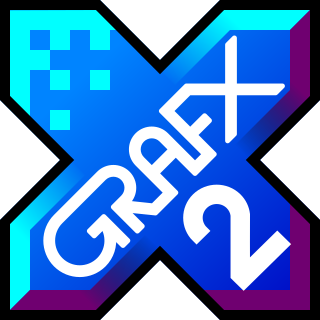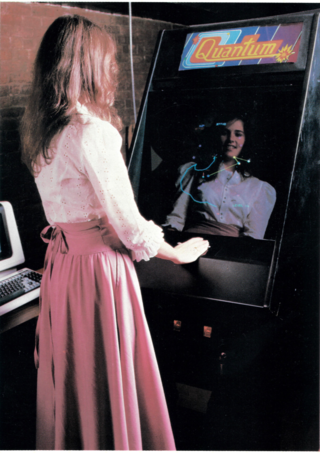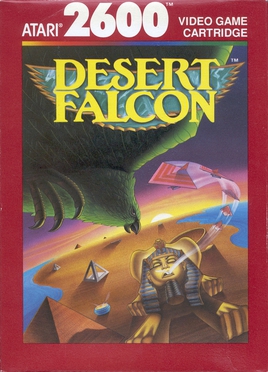
The Atari 2600 is a home video game console developed and produced by Atari, Inc. Released in September 1977 as the Atari Video Computer System, it popularized microprocessor-based hardware and games stored on swappable ROM cartridges, a format first used with the Fairchild Channel F in 1976. The VCS was bundled with two joystick controllers, a conjoined pair of paddle controllers, and a game cartridge—initially Combat and later Pac-Man. Sears sold the system as the Tele-Games Video Arcade. Atari rebranded the VCS as the Atari 2600 in November 1982 alongside the release of the Atari 5200.

The Atari 7800 ProSystem, or simply the Atari 7800, is a home video game console officially released by Atari Corporation in 1986 as the successor to both the Atari 2600 and Atari 5200. It can run almost all Atari 2600 cartridges, making it one of the first consoles with backward compatibility. It shipped with a different model of joystick from the 2600-standard CX40 and Pole Position II as the pack-in game. Most of the announced titles at launch were ports of 1981–1983 arcade video games.

Missile Command is a 1980 shoot 'em up arcade video game developed and published by Atari, Inc. and licensed to Sega for Japanese and European releases. It was designed by Dave Theurer, who also designed Atari's vector graphics game Tempest from the same year. The game was released during the Cold War, and the player uses a trackball to defend six cities from intercontinental ballistic missiles by launching anti-ballistic missiles from three bases.

Centipede is a 1981 fixed shooter arcade video game developed and published by Atari, Inc. Designed by Dona Bailey and Ed Logg, it was one of the most commercially successful games from the golden age of arcade video games and one of the first with a significant female player base. The primary objective is to shoot all the segments of a centipede that winds down the playing field. An arcade sequel, Millipede, followed in 1982.

Howard Scott Warshaw, also known as HSW, is an American psychotherapist and former game designer. He worked at Atari, Inc. in the early 1980s, where he designed and programmed the Atari 2600 games Yars' Revenge, Raiders of the Lost Ark, and E.T. the Extra-Terrestrial.

Choplifter is a military themed scrolling shooter developed by Dan Gorlin for the Apple II and published by Broderbund in 1982. It was ported to the Atari 8-bit family the same year and also to the VIC-20, Commodore 64, Atari 5200, ColecoVision, MSX, and Thomson computers.

Summer Games is a sports video game developed and published by Epyx based on sports from the Summer Olympic Games. Released in 1984 for the Commodore 64, it was ported to the Apple II, Atari 2600, Atari 7800, Atari 8-bit family, and Master System.

The Atari Flashback series are a line of dedicated video game consoles designed, produced, published and marketed by AtGames under license from Atari SA. The Flashback consoles are "plug-and-play" versions of the Atari 2600 console. They contain built-in games rather than using the ROM cartridges utilized by the 2600. Most of the games are classics that were previously released for the 2600, although some Flashback consoles include previously unreleased prototype games as well.
Atari Corporation was an American manufacturer of computers and video game consoles. It was founded by Jack Tramiel on May 17, 1984, as Tramel Technology, Ltd., but then took on the Atari name less than two months later when Warner Communications sold the home computing and game console assets of Atari, Inc. to Tramiel. Its chief products were the Atari ST, Atari XE, Atari 7800, Atari Lynx and Atari Jaguar.

Dandy is a dungeon crawl maze game for the Atari 8-bit family published by the Atari Program Exchange in 1983. It is one of the first video games with four-player, simultaneous cooperative play. Players equipped with bows and unlimited arrows fight through a maze containing monsters, monster spawners, keys, locked doors, food, and bombs in search of the exit leading to the next level. If a player dies, they can be revived by finding and shooting a heart. The game includes an editor for making new dungeons.

The Atari 2600 hardware was based on the MOS Technology 6507 chip, offering a maximum resolution of 160 x 192 pixels (NTSC), 128 colors, 128 bytes of RAM with 4 KB on cartridges. The design experienced many makeovers and revisions during its 14-year production history, from the original "heavy sixer" to the Atari 2600 Jr. at the end. The system also has many controllers and third-party peripherals.

GrafX2 is a bitmap graphics editor inspired by the Amiga programs Deluxe Paint and Brilliance. It is free software and distributed under the GPL-2.0-only license.
Cyber Studio CAD-3D is a 3D modeling and animation package developed by Tom Hudson for the Atari ST computer and published by Antic Software. The package is a precursor to 3D Studio Max.

Demons to Diamonds is a fixed shooter for the Atari 2600 produced by Atari, Inc. and released in 1982. It was programmed by Nick Turner with graphics designed by Alan Murphy. Nick Turner previously ported Super Breakout to the 2600. The manual states that the game was "primarily designed for children in the 6 to 12 age range."

The first hobbyist-developed game for the Atari 2600 video game console was written in 1995, and more than 100 have been released since then. The majority of games are unlicensed clones of games for other platforms, and there are some also original games and ROM hacks. With only 128 bytes of RAM, no frame buffer, and the code and visuals closely intertwined, the 2600 is a difficult machine to program. and many games were written for the technical challenge. Emulators, programming tools, and documentation are available.
Carla Meninsky is a former video game designer and programmer active during the early years of the Atari VCS. Along with Carol Shaw, Meninsky was one of three female engineers at Atari, Inc. to develop video game cartridges. She later became an intellectual property lawyer.

Crack'ed, subtitled "An Egg-Citing Adventure," is a target shooting video game developed by Robert Craig for the Atari ST and released by Atari Corporation in 1988. An Atari 7800 port was published the same year. In Crack'ed the player must protect bird eggs by shooting predators.

The Atari CX40 joystick was the first widely used cross-platform game controller. The original CX10 was released with the Atari Video Computer System in 1977 and became the primary input device for most games on the platform. The CX10 was replaced after a year by the simpler and less expensive CX40. The addition of the Atari joystick port to other platforms cemented its popularity. It was the standard for the Atari 8-bit family of home computers and was compatible with the VIC-20, Commodore 64, Commodore 128, MSX, and later the Atari ST and Amiga. Third-party adapters allowed it to be used on other systems, such as the Apple II, Commodore 16, TI-99/4A, and the ZX Spectrum.

Elizabeth (Betty) Ryan is an American game developer and programmer. She worked for General Computer Corporation (GCC) in the 1980s and was the 9th employee and first woman video game programmer at GCC. She programmed the 1982 Atari, Inc. arcade game Quantum as well as working on games for the Atari 2600, Atari 5200, and Atari 7800.

Desert Falcon is a scrolling shooter developed by General Computer Corporation for the Atari 7800 and Atari 2600 and published by Atari Corporation in 1987. It was initially announced in 1984, prior to being named Desert Falcon, as one of the planned launch titles for the 7800. A cartridge version for the Atari 8-bit family, with XEGS-styled packaging, followed in 1988.
















